Transition from 50 to 30
In recent years, most cities strive to become more sustainable and livable through reducing the impacts of car traffic. For more and more cities one step is to reduce the maximum speed that cars are allowed to drive. In the same line, Amsterdam plans to reduce the maximum speed on most of its main streets to 30 km/h in late 2023, increasing the percentage of streets with a speed limit of 30 km/h from 70% to 82% (1)
In this blog we will discuss street usage over time and how speed limit reduction can help in making cities, like Amsterdam, more liveable and safer. We start with the historical context and give an overview over motivations, debates, effects, and blind spots that in general accompany such a speed limit reduction. Then we will describe the case of Amsterdam and how it provides a valuable opportunity to investigate more indirect and secondary effects of reduced speed limits.
(1): Personal communication with officials from the City of Amsterdam
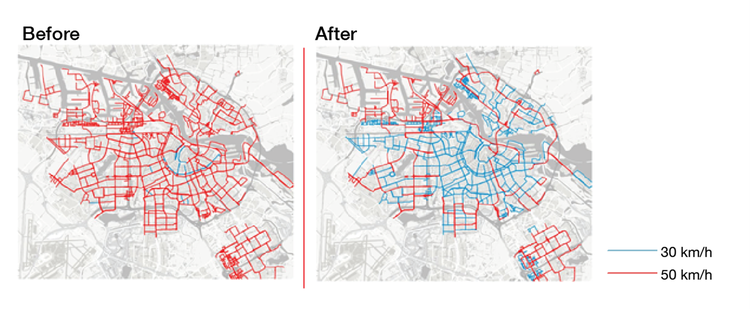
Transition: Amsterdam’s main streets changing to 30 km/h (maps.amsterdam.nl)
Street usage and vehicle speeds in history
Historically, urban streets were the space where a multitude of activities happened, e.g. work, trade, washing, social interactions, and child play. Transport of people and goods was just one among these many usages. Interestingly, conflicts about street space usage go back to at least ancient Rome, where Julius Caesar banned commercial deliveries during daytime due to congestion (2). A similar conflict arose when the first automobiles appeared in the 19th century. They were extremely noisy, took a lot of space and were dangerous for people, resulting in a broad opposition. Exemplary is the “Red Flag Act”, which in the UK introduced a speed limit of 3.2 km/h for automobiles and required that a person waving a red flag walked in front of each car (3). In the 1920s the bicycle had the highest mode-share in most European cities.
(2) Fu J. & Jenelle’s E. (2018): Efficiency of off-peak urban goods deliveries: A Stockholm pilot study
(3) Wikipedia: Red Flag Traffic Laws
Red Flag Act: Early safety measure for automobiles (https://www.andtodayis.com)
This changed with the uprising of modernism, where cars were increasingly seen as the future transport mode and the symbol of wealth and progress. Car usage rose and the car and oil lobby became increasingly powerful. They were able to introduce laws which favored the free flow of vehicles on the expense of all other street usages. Even crossing streets by foot was forbidden except for specific locations. A feedback loop emerged: the more and bigger roads were built, the faster people could travel longer distances by car, which made more people to buy automobiles and have activities further distanced apart. This caused more car traffic which again made it necessary to build more and bigger roads, and so on.
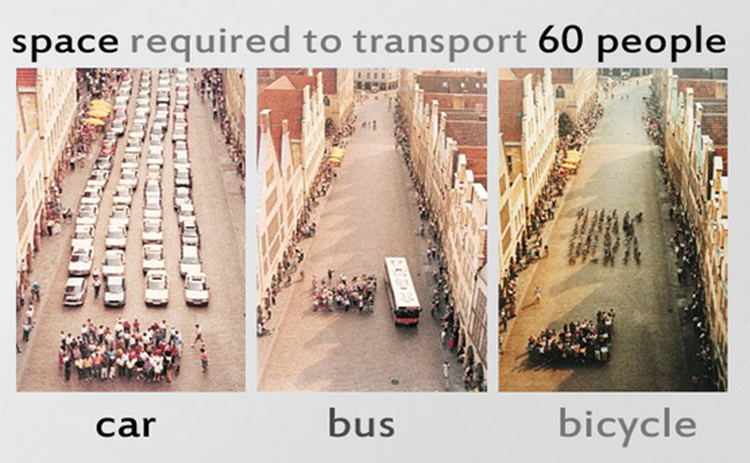
The use of space: Different modes of transport in comparison (Stadtwerke Munster)
Negative impact of cars in the cities
The closer reality got to the “car-centered utopia” envisioned by modernists, however, the more the problems become apparent: many people get injured and killed, noise and air pollution seriously affect public health, highways, streets and parking areas take a substantial amount of space and thereby divide communities and take over the public place. Other modes and activities, like biking and walking are pushed off the streets. , The role of the car in urban streets becomes increasingly problematic for children, adolescents, old, or poor people, and everyone who simply doesn’t like driving. Related to space use, car-traffic, opposed to other modes is extremely inefficient what makes even very wide streets quickly clocked-up.
Amsterdam in 70s: A street occupied by cars (Pinterest)
More and more scientific studies show that secondary effects of car-oriented cities could lead to many disadvantages,: for example children lack autonomy and have impaired spatial navigation skills, social interactions and social cohesion decrease since residents spend less time in the street and neighbors don’t bump into each other, social safety and crime become problematic since there are “no eyes” on the street and residents don’t feel responsible so much for the neighborhood, and people who can’t afford a car lack economic opportunities which makes it hard for them to escape poverty.
A turning trend - many cities implement a speed limit of 30 km/h
As these problems of high car usage are increasingly recognized, many cities around the globe want to increase livability by reducing car usage or at least its negative impacts. In Amsterdam for example the low car agenda was initiated and the reduction of speed in more street is an active measure to create better livability in Amsterdam’s neighborhoods.
The following map provides an overview of some exemplary European cities which have agreed to reducing speed limits to 30 km/h. Reducing the maximum speed that cars are allowed to drive is a relatively easy and quickly to implement step in this direction. When looking more closely at the motivations and goals of these cities it becomes apparent that they slightly differ in their focus.
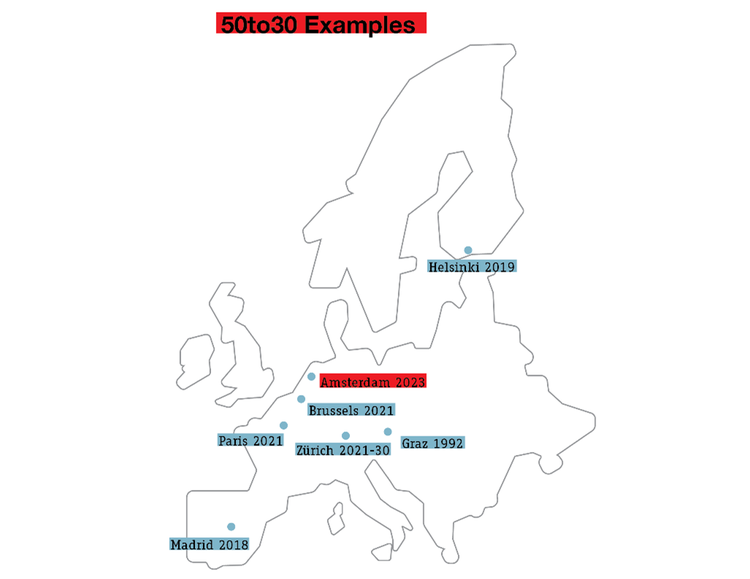
50to30 Examples: Map of Europe with cities pursuing 30 km/h
Almost all cities state the reduction of injured or killed people as an important motivation. Zürich is the only city which officially states only the reduction of noise as motivation. Indeed, a lower speed heavily reduces the danger of serious injuries since the relationship between vehicle speed and collision occurrences and impacts is highly nonlinear.
50to30 Safety: Survival rate at different car speeds
Most cities are also motivated by the expected noise reduction. Other motivations are a general reduction in car usage, an increase in walking and cycling, the reduction of air pollution, improved public health, an increased significance of public space, as well as increased livability and quality of life. These effects often influence and further reinforce each other: public health, for example, is improved by noise reduction (mostly due to reduced stress levels) and cycling/walking. Similarly, less noise makes cycling/walking more attractive what again reduces car traffic and air pollution.
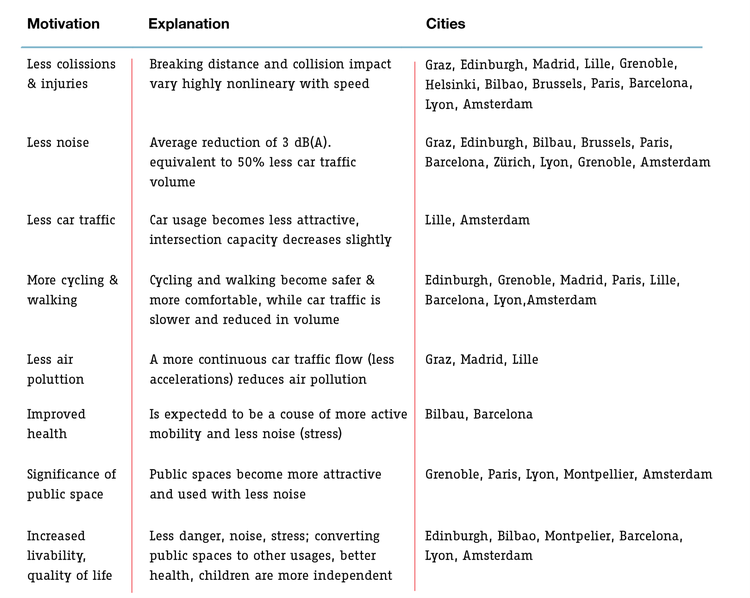
“More and more cities are reducing the speed limits, showcasing the positive effects of the measure, and encouraging other cities to follow it.”
Petar Koljensic
Former Intern Smart Urban Mobility at AMS Institute

Benefits of the transition
Apart from the relatively easy to measure quantities like collision statistics, traffic flow, travel times, noise levels, and mode share, there currently exists little knowledge about how a reduced speed limit influence aspects like livability, the importance of public space, social interactions, social safety, social cohesion, quality of life, children’s independence, and physical and mental health.
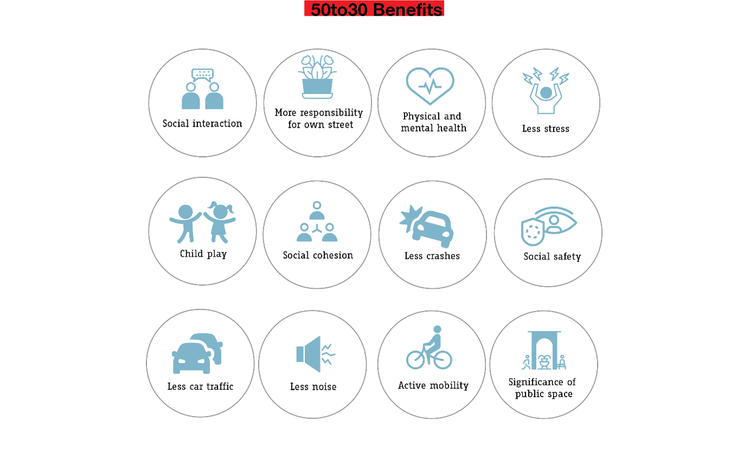
Benefits: For urban surroundings after transition from 50 to 30
Potential drawbacks and challenges
Besides the benefits there are potential drawbacks and challenges towards speed reduction. The table below lists the drawbacks and challenges that might occur when lowering the speed limit for cars. Cities which have already reduced their speed limits and have measured the effects demonstrated that the drawbacks are manageable or negligible. In general, a pattern is visible that is already well-known from other measures to reduce car traffic: before the reduced speed limit is implemented the support is usually rather low. A few months or years after the implementation, however, a great majority supports the reduced speed limit.
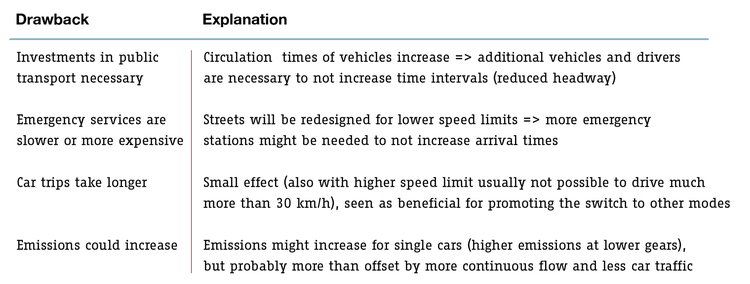
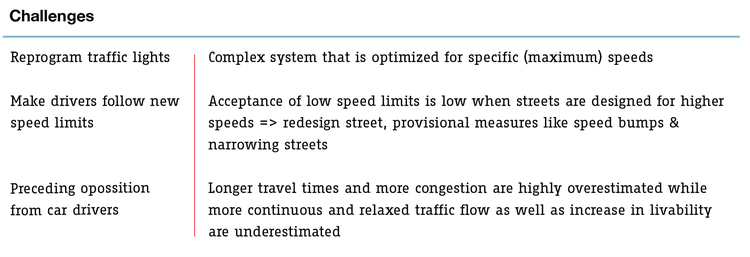
Impact Study 50 to 30 km/h
The City of Amsterdam is going to monitor and evaluate the impact of the speed reduction in terms of accidents traffic collisions, accessibility, public transport implications, and noise and air pollution. Together with the scientific community of Amsterdam, AMS Institute and the municipality are preparing an extended study on the impact that this change has. Besides the previous mentioned indicators, it will look into the impact on (and design of) public space Amsterdam’s public space, the broader impact on mobility for different modalities, the street network and logistics. Furthermore it will focus on the impact on society, societal costs and benefits, and inclusivity.
“Reducing the speed of cars in cities is a good and necessary step, but more steps are needed to substantially relieve cities from the burden of extensive car traffic.”
Kai Röth PhD - Urban Mobility Researcher

The future
More and more cities see a speed limit of 30 km/h as an important step to reduce the negative impacts of car traffic and make cities more livable. The knowledge about certain effects of a smaller speed limit is already extensive (e.g. collision statistics, noise), while other effects are not well-studied until now (e.g. social interaction, social cohesion, children’s independence, livability, importance of public space, switch to other modes, physical and mental health). The case of Amsterdam provides an opportunity to also study these effects and this opportunity should not be missed.
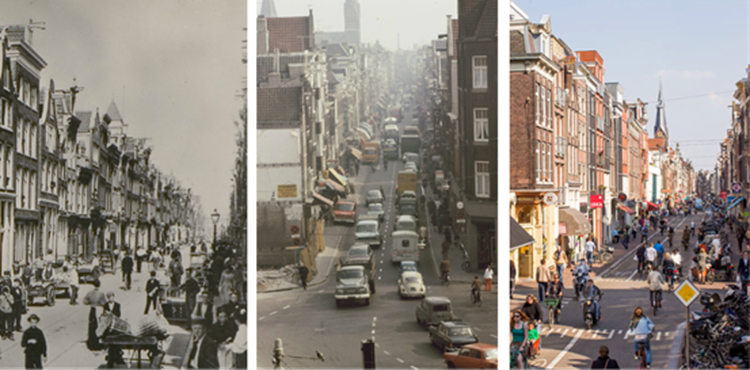
Amsterdam Street: A change of mobility aspects over time (https://exploring-and-observing-cities.org/)
